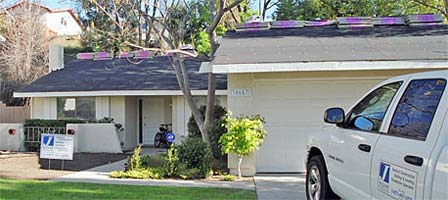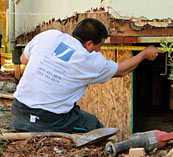 The main purpose of a roof is protection – preventing rain, wind and other environmental elements from damaging the building’s structure. A roof will eventually wear out and need to be replaced. Other reasons for re-roofing include improving the appearance of a home and increasing its value.
The main purpose of a roof is protection – preventing rain, wind and other environmental elements from damaging the building’s structure. A roof will eventually wear out and need to be replaced. Other reasons for re-roofing include improving the appearance of a home and increasing its value.
There are many different types of materials that can be used for roofing, including wood shake, asphalt, tile and metal.
Wood shake roofs are usually manufactured from pine, redwood, cypress or cedar. They are thicker on one end than the other, and frequently come with a surface split that creates a textured appearance.
Asphalt roof shingles come in many different styles and colors, and can be used on both commercial and residential buildings. There are several different styles of asphalt shingles, including tiles that look like slate or old-fashioned roofing shingles.
Tile roofs are known for their appearance and durability. They require very little maintenance and will generally last longer that other types of roofing material. The two main types of tile roofs are clay and concrete. Both come in colors and special finishes.
Metal roofs will also last for many years. They are typically used for commercial projects, but can be installed on residential properties as well. Metal roofs are one of the best choices for protecting a home against the wind.
Reroofing a house may be necessary if there are missing, loose, warped, cracked or buckled shingles and tiles. Large gaps between shingles and tiles can also require reroofing, as well as a sagging roof or shingles that have been worn down by the weather. When shingles or tiles are damaged in any way, the underlying roofing materials are exposed to the elements.
In addition to weather, there are other factors that can cause a roof to deteriorate and require replacing, including poor design, incorrect installation, poor maintenance and pollution.
A badly designed roof can lead to sagging, loose tiles and splitting. A poor design can also cause water and sediment to accumulate on the roof, which can damage the structure. A roof that hasn’t been installed correctly can result in similar issues.
Roofs need to be properly maintained, such as keeping drains free of debris. Clogged drains will eventually lead to water buildup, which can damage both the roof and underlying structure.
Another potential source of roofing problems is flashing, a thin layer of waterproof material used to prevent water from seeping into a home. It is placed where the roof intersects with pipes, vents, chimneys and skylights. When flashing isn’t properly installed, fastened or adhered, water can leak through the roof and into the building, damaging drywall.
Spring is a good time to inspect a roof. However, a damaged roof can be replaced at any time, even when it is raining. A specialist in roof shingle installation should inspect your home and roof at least once a year. Identifying and fixing roof problems quickly can minimize the cost of repairs and prevent more serious structural issues from occurring.
 The three main methods of foundation repair for foundation cracks are epoxy injections, strapping and underpinning. Epoxy injections are known for their toughness, excellent adhesion, low shrinkage and resistance. Strapping is the process of installing carbon-fiber Kevlar straps which have considerable strength and are easy to work with. Underpinning can be done in addition to the above, with the purpose increasing the depth or width of the foundation. The company recommended consulting a professional foundation expert to determine what kind of foundation crack you are facing and what the appropriate method is to handle the problem.
The three main methods of foundation repair for foundation cracks are epoxy injections, strapping and underpinning. Epoxy injections are known for their toughness, excellent adhesion, low shrinkage and resistance. Strapping is the process of installing carbon-fiber Kevlar straps which have considerable strength and are easy to work with. Underpinning can be done in addition to the above, with the purpose increasing the depth or width of the foundation. The company recommended consulting a professional foundation expert to determine what kind of foundation crack you are facing and what the appropriate method is to handle the problem.